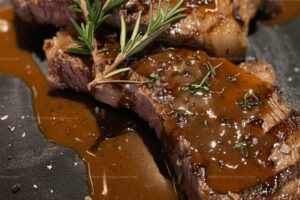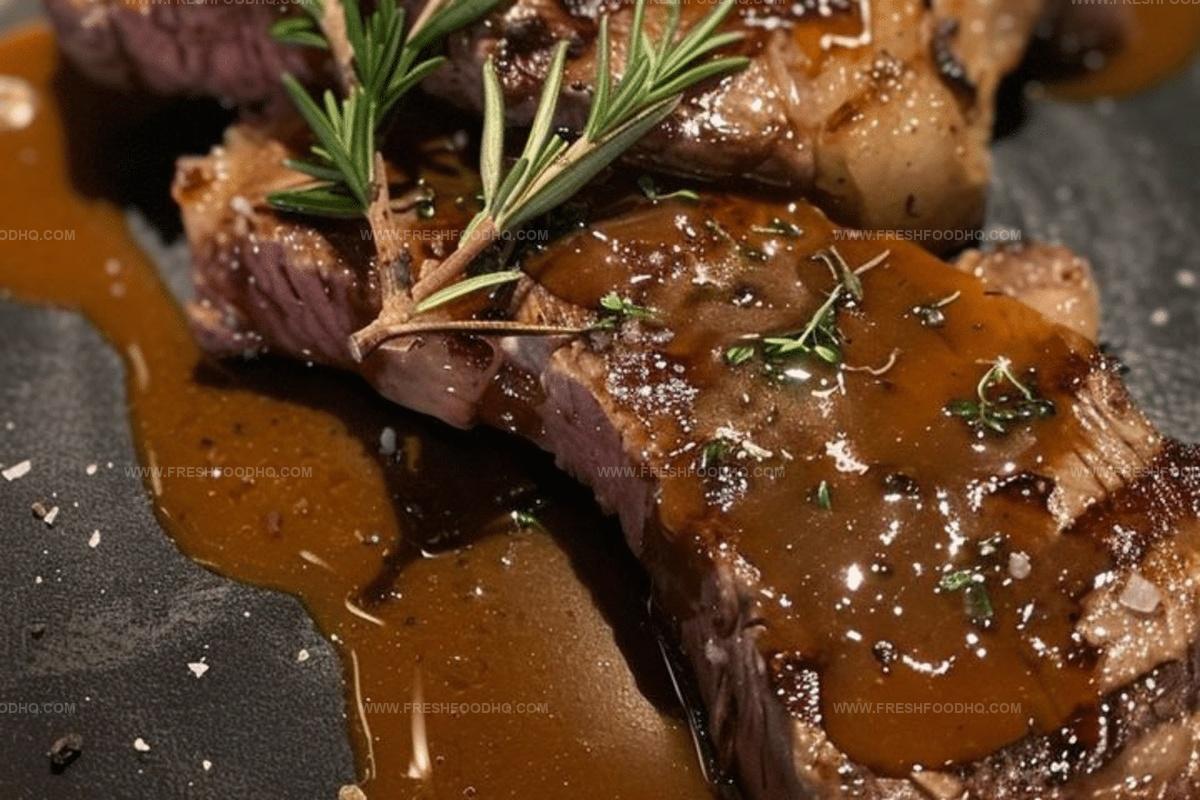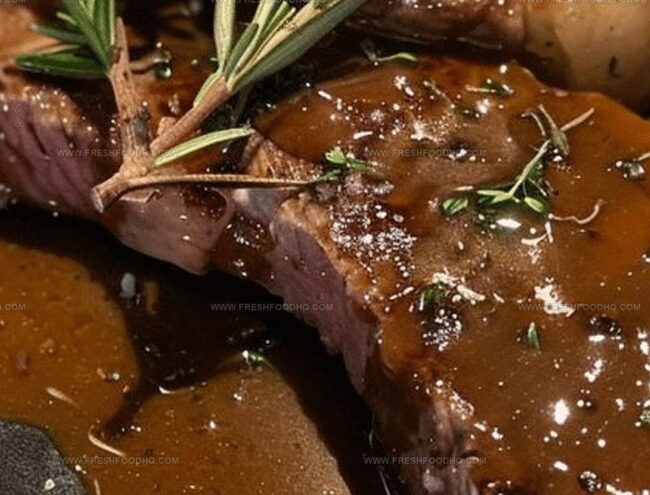Sizzling Ribeye Steak Recipe for Juicy, Flavorful Perfection
Juicy ribeye steak promises a mouthwatering culinary adventure that transforms your home kitchen into a gourmet paradise.
Meat lovers constantly search for the perfect preparation technique.
Selecting premium cuts makes all the difference in creating restaurant-quality results.
Quality ingredients and precise cooking methods separate amateur cooks from true culinary artists.
Seasoning plays a crucial role in developing rich, complex flavors that dance across your palate.
Salt and pepper might seem simple, but they unlock deep, magnificent taste profiles.
You can elevate this classic dish with minimal effort and maximum impact.
Let’s master the art of cooking a phenomenal ribeye that will impress everyone at your table.
What Makes Ribeye Steak So Flavorful
Ingredients for Ribeye Steak
Main Protein:Seasoning:Cooking Accompaniments:How to Cook Ribeye Steak
Step 1: Warm Up the Steaks
Take the ribeye steaks out of the refrigerator and allow them to relax at room temperature for half an hour. This helps the meat cook more evenly and ensures a tender result.
Step 2: Sprinkle with Seasoning
Generously coat both sides of the steaks with salt and black pepper. The seasoning will create a delicious crust and enhance the natural beef flavors.
Step 3: Prepare the Cooking Surface
Place a cast-iron skillet or heavy-bottomed pan on high heat. Drizzle a thin layer of olive oil to prevent sticking and help create a perfect sear.
Step 4: Sear the Steaks
Carefully place the seasoned steaks into the hot skillet. Cook for 3-4 minutes on each side for a medium-rare finish. For different levels of doneness, adjust the cooking time slightly.
Step 5: Add Aromatic Boost
During the final minute of cooking, toss in:These ingredients will infuse the steaks with an incredible depth of flavor.
Step 6: Let the Meat Rest
Transfer the steaks to a cutting board and let them rest for 5 minutes. This allows the juices to redistribute, ensuring a juicy and tender bite.
Step 7: Serve and Savor
Slice the steaks against the grain and plate immediately. Enjoy your perfectly cooked ribeye with your favorite sides.
Pro Tips for Perfect Ribeye Steak
Variations to Try with Ribeye Steak
Pairing Ideas for Ribeye Steak
Proper Storage for Ribeye Steak
FAQs on Ribeye Steak
Use a meat thermometer to check internal temperature: 125°F for rare, 135°F for medium-rare, 145°F for medium, and 160°F for well-done.
Yes, you can grill ribeye steaks over high heat. Preheat the grill to 450-500°F and follow similar cooking times, turning once halfway through.
Resting allows the meat’s juices to redistribute, ensuring a more tender and flavorful steak. This prevents the juices from immediately running out when you cut into the meat.
Print
Ribeye Steak Recipe
- Total Time: 38-40 minutes
- Yield: 2 1x
Description
Succulent ribeye steak lovers discover culinary magic with this simple yet sophisticated recipe that elevates home cooking. Juicy, perfectly seared meat promises a restaurant-quality experience right from your kitchen, inviting you to savor every flavorful bite.
Ingredients
Main Protein:
- 2 ribeye steaks
Seasonings:
- Salt, to taste
- 2 cloves garlic, minced
- Pepper, to taste
Fresh Herbs and Oil:
- Olive oil
- Fresh herbs (rosemary, thyme, etc.)
Instructions
- Allow ribeye steaks to reach ambient temperature for approximately 30 minutes, ensuring even cooking and optimal tenderness.
- Liberally apply kosher salt and cracked black pepper across both surfaces of the meat, creating a flavorful exterior crust.
- Preheat a heavy-bottomed cast-iron skillet to high heat, creating a smoking hot cooking surface.
- Drizzle a thin layer of olive oil into the skillet, creating a protective barrier and enhancing potential caramelization.
- Carefully place steaks into the scorching skillet, allowing each side to develop a rich, golden-brown sear for 3-4 minutes.
- During the final cooking moments, introduce minced garlic and fresh thyme or rosemary to intensify the aromatic profile.
- Test doneness using a meat thermometer – 125°F for rare, 135°F for medium-rare, or 145°F for medium.
- Transfer steaks to a clean cutting board, allowing them to rest undisturbed for 5-7 minutes to redistribute internal juices.
- Slice against the grain and serve immediately, preserving the steak’s optimal temperature and succulence.
Notes
- Let the steaks rest at room temperature to ensure even cooking and a tender texture.
- Use coarse sea salt and freshly ground black pepper for maximum flavor enhancement.
- Pat the steaks dry with paper towels before seasoning to create a perfect golden-brown crust.
- Opt for a cast-iron skillet to achieve the best heat distribution and beautiful sear marks.
- For different dietary preferences, try using avocado oil instead of olive oil for a higher smoke point.
- Experiment with herb variations like rosemary, thyme, or sage to customize the steak’s flavor profile.
- Check doneness using a meat thermometer for precise results: 125°F for rare, 135°F for medium-rare.
- Prep Time: 30 minutes
- Cook Time: 8-10 minutes
- Category: Lunch, Dinner
- Method: Sautéing
- Cuisine: American
Nutrition
- Serving Size: 2
- Calories: 400 kcal
- Sugar: 0 g
- Sodium: 300 mg
- Fat: 32 g
- Saturated Fat: 13 g
- Unsaturated Fat: 17 g
- Trans Fat: 1 g
- Carbohydrates: 1 g
- Fiber: 0 g
- Protein: 30 g
- Cholesterol: 90 mg




Samantha Lee
Recipe Developer & Content Creator
Expertise
Plant-based and vegetarian recipes, Recipe testing and development, Food blogging and digital content creation, Culinary education and workshops
Education
Oregon Culinary Institute (Portland, OR)
Samantha sees cooking like painting, every fresh herb, every juicy tomato, a new splash of color on a canvas.
After graduating from Oregon Culinary Institute, she blended her love of global cuisines and plant-based cooking into recipes that feel fresh, fearless, and full of heart.
Samantha’s kitchen is a place where comfort food gets a modern remix and every meal feels like a little adventure. When she’s not cooking, she’s out exploring farmers’ markets, sketching new recipe ideas, or getting her hands dirty in a community garden.